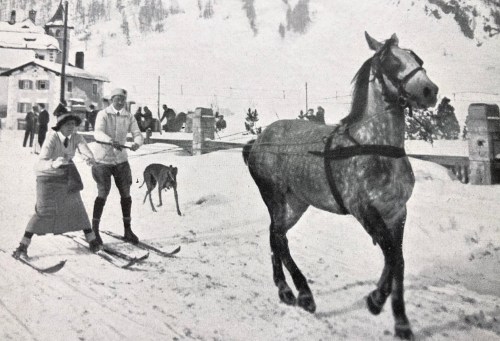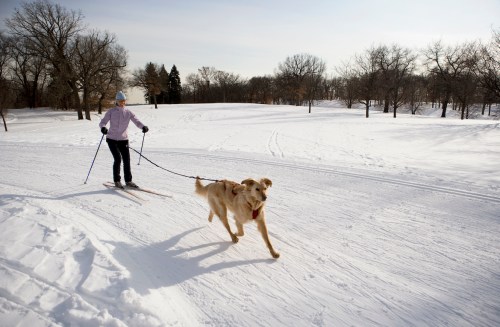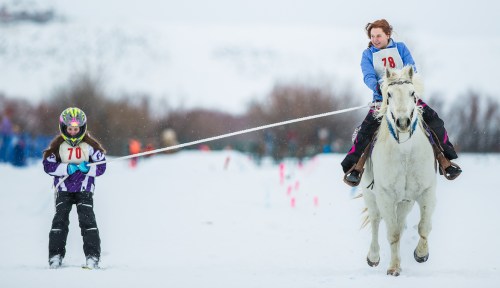For a guaranteed good time, search “skijoring” on TikTok. You’ll find songs like Cotton Eye Joe and Man, I Feel Like a Woman soundtracking skiers doing jumps and flips down a town’s Main Street, USA—all while being pulled by a galloping horse.
Experts in This Article
Welcome to the world of skijoring, or, as one TikTokker puts it, “the wildest sport on six legs.” Skijoring means “to be driven forward” in Norwegian, according to historian Loren Zhimanskova, who—as a practitioner, fan, and community leader of the sport—has taken it upon herself to meticulously catalog skijoring’s origins. Today, it usually involves being “driven forward” by a horse or a dog, and skijoring competitions have become increasingly popular in the U.S. and Canada.
The practice of strapping boards of wood to your feet and getting pulled forward by dogs actually began as a mode of transportation thousands of years ago: It was first recorded by Persian historians in the mountains of Central Asia. Skijoring as a sport originated in the late 19th or early 20th century in Scandinavia, where athletes raced while getting pulled by reindeer. People in parts of Europe including France and Poland also practiced skijoring, but with horses. Horseback skijorers can either work with a partner who rides and reins the horse, or they can even rein the horse themselves. Yep, that means driving a horse while you’re on skis.
Skijoring made its way across the pond in the 20th century, taking root in the Northeast, and eventually gaining popularity in cowboy-friendly areas out west. When a skijor competition takes place, it has the feel of a “winter rodeo,” says Zhimanskova.
“It’s a great community,” says Zhimanskova. “People travel the circuit together.”

That circuit has gotten bigger of late. Zhimanskova runs digital hubs that advertise and keep track of all the races both in North America and internationally, and she helms a consortium of race leaders working to promote the sport. She says there are now around 30 North American races per year—a number that’s tripled over the last decade.
It’s easy to see why social media and photography have hastened the spread: The spectacle of skijoring is a blast to behold. But Zhimanskova thinks more people are participating, too, because there are multiple types of race days. Some are intense two-day competitions featuring obstacle courses and speeds of up to 40 miles per hour, while others are single-day, novice-friendly events.
Novice-friendly, that is, as long as you’re comfortable around horses and on skis. As cool as skijoring looks, you shouldn’t attempt the sport unless you’re familiar with the feeling of skiing, Zhimanskova advises. And even then, make sure to take it slow—trot before you gallop, friends.
The same goes for skijoring with dogs, says Filippo Ricotti, who runs the sport and utility dog gear company Neewa.
“You can catch some speed,” says Ricotti, so “you need to be able to ski comfortably for the safety of the dog and your own safety.”
Ricotti, who is based in Italy, has been skijoring for years in the Dolomites with huskies and a few other breeds. His company Neewa sells skijoring harnesses, leashes, belts, and dog boots.

Dogs won’t pull you with the same intensity as horses, so it’ll be more like cross-country skiing where you’re pulling much of your own weight, with a little assistance from Fido.
It’s best to get some expert guidance before skijoring with a horse for the first time—this is not something you should try on your own. But if you want to attempt skijoring with your dog, Ricotti says it’s doable for advanced skiers, as long as you take it slow and work up to it. Start out running with your dog—like, without snow. Then, you can try rollerblading. If all goes well when winter comes around, and you’re familiar with downhill and cross-country skiing, you can slowly give skijoring a try. Cross-country terrain is best. Make sure you have the right gear, and ensure you’ve got at least 10 feet of distance between you and your dog. But don’t subject your dog to pulling if you are more than three or four times your dog’s weight, which is what Ricotti advises is the maximum load.
Be prepared for a serious core, arm, and leg workout, as well as a major challenge for your agility and your balance, says Zhimanskova. Ricotti says skijoring is a great way for the dogs to get their energy out, and Zhimanskova says horses are into it, too.
“A lot of my friends that have horses say when they’re loading up their horses in the wintertime, the horses know they’re going to a skijoring event and they’re really excited, they get to see their buddies,” Zhimanskova says. “Just like they’re having fun in the summer months, they’re having fun in the winter months, too.”
Sign Up for Our Daily Newsletter
Get all the latest in wellness, trends, food, fitness, beauty, and more delivered right to your inbox.
Got it, you've been added to our email list.











